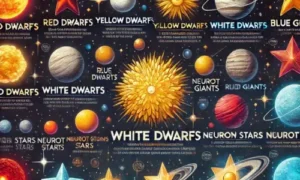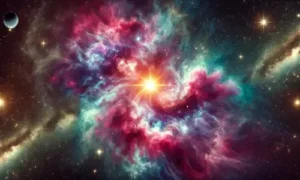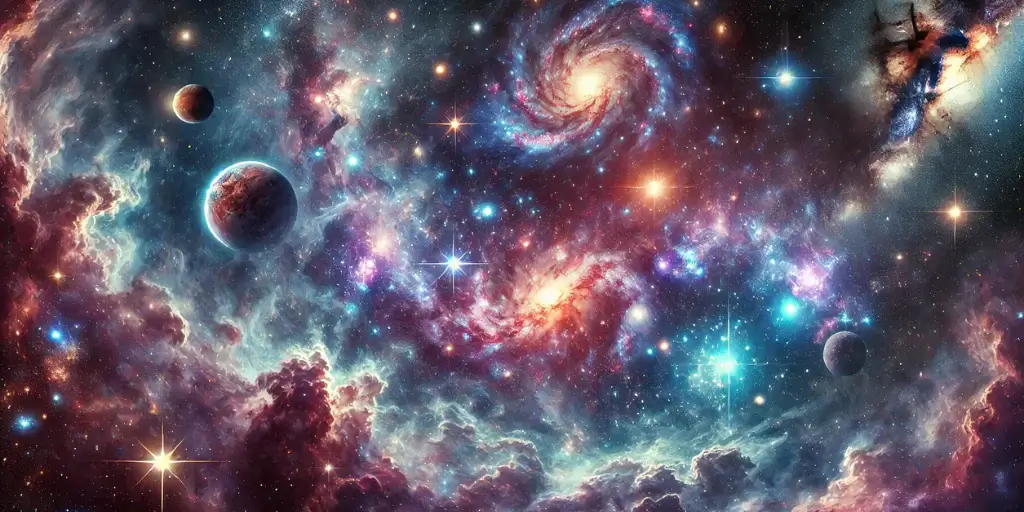Recently updated on December 18th, 2024 at 09:30 am
A star is a large, brilliant sphere of hot gas, usually hydrogen and helium, that generates energy by nuclear fusion at its centre. Consequently, this fusion process produces light and heat, making Cosmic light visible from great distances in space.
What is the process of star formation?
Furthermore, nebulae, or clouds of gas and dust in space, are where stars develop. The process of celestial body creation typically follows these steps:
- Firstly, Gravity Pulls Matter Together: Gravity attracts particles within a nebula, resulting in dense zones.
- Next, Protostar Formation: As these zones get denser, they heat up and form a protostar.
- Then, Nuclear Fusion Ignition: When the core temperature hits around 10 million degrees Celsius, nuclear fusion begins, transforming hydrogen to helium and generating energy.
- Finally, Stable Star: Once fusion begins, the outward pressure balances the gravitational force, resulting in a stable Luminous sphere known as the main sequence stage.
Definition of Star
A star is a self-luminous celestial body composed of heated gasses that produce energy through nuclear fusion. Consequently, the energy created counteracts gravitational collapse, keeping the Luminous sphere stable and allowing it to emit light and heat.
Light Emission of star

Stars glow due to the energy released during nuclear fusion. In this process, this energy moves from the core to the outer layers, where it is released as visible light and other radiation.
As a result, the light and heat emitted make the Celestial body visible from Earth and supply energy to adjacent planets.
Types and names of stars

Stars are classed according to their mass, colour, temperature, and stage of life. Common types include:
- Red Dwarfs: Red dwarfs are small, cold stars that burn fuel slowly.
- Yellow Dwarfs: Medium-sized stars, similar to our Sun, with moderate temperatures.
- White Dwarfs: White dwarfs are the fading remnants of smaller stars.
- Giant and Supergiant: Massive, brilliant stars at the end of their lives.
- Neutron: Neutron stars are the dense remains of exploded supernovae.
- Binary: Systems comprising two stars that orbit each other.
Well-known celebrities include:
- For instance, Sirius is the brightest star in the nighttime sky.
- Additionally, Betelgeuse is a red supergiant in the constellation Orion.
- Moreover, Polaris (North Star) serves as a navigational reference point.
- Finally, Alpha Centauri is the nearest star system to the sun.
Interesting Facts about star
- Distance: The Sun is the closest star to Earth, around 93 million miles away.
- Temperature: Cool red dwarfs have temperatures of about 2,000°C, while heated blue stars have temperatures of around 30,000°C.
- Size Range: Stars can be of the Sun’s radius to more than 1,000 times bigger.
- Life Cycle: A star’s lifecycle can last millions to billions of years, from formation to collapse, resulting in a white dwarf, neutron, or black hole.
- Twinkling: appears to twinkle because the Earth’s atmosphere bends its light, generating little fluctuations in brightness.
Stars are vital to the universe because they create elements heavier than hydrogen and helium through fusion, enriching the cosmos for future Cosmic light and planet formation.
Conclusion
In summary, stars are brilliant celestial bodies formed by the gravitational collapse of gas and dust in space, resulting in nuclear fusion at their core. This fusion produces light and energy, making stars visible from great distances.
The celestial body appears in a variety of shapes, sizes, and temperatures, and each has a distinct lifespan that adds vital materials to the cosmos.
Stars are important in the universe because they shape galaxies, influence planetary systems, and allow life to exist by supplying light and warmth.







